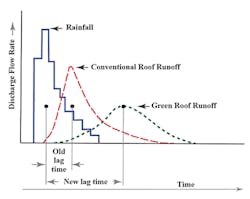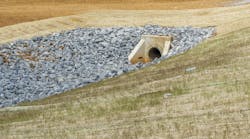Sponsored Content: Green Roofs As a Stormwater Management Tool
The green roof industry is growing steadily in response to the need for communities and developers to manage stormwater more effectively. Green roofs are often the only effective way to meet regulatory requirements and also confer a wide range of additional benefits. As a stormwater best management practice, green roofs address stormwater in several ways: They work to reduce the overall runoff volume, thereby attenuating peak runoff; they delay the onset of runoff; and they extend the duration of runoff relative to conventional rooftops, greatly reducing flow rates into sewer systems. (See hydrograph.) Depending on the intensity and duration of the rain event, some water will slowly drain and some will be retained on the roof, largely in the growing medium and drainage layers, to be evaporated or transpired by the plants, providing retention recharge capacity.
The stormwater management capacity of a green roof depends on a number of factors, including the depth and composition of the growing medium; the type and amount of coverage of the plants; the slope of the roof; the presence of layers specially designed to capture, hold and/or delay water; and the size of the green roof. There are also hybrid green/blue roof systems that incorporate significant water storage and reuse capacity.
Typical rainfall and runoff hydrograph for conventional and green roofs
In addition to managing stormwater, green roofs can provide public and private benefits that help to improve quality of life. These include noise reduction; increase property values; biodiversity opportunities, particularly pollinators and migratory birds; greenhouse gas sequestration; and the ability to cool not only the building, but the surrounding area in order to help combat the urban heat island effect. A cost-benefit study on green roofs by ARUP Engineering for the General Services Administration found in excess of $30 per square foot of public benefits can be realized from extensive green roofs. Public benefit valuations, combined with the need to manage stormwater, have led many large local governments to either invest directly in, or require, green roof installations. Among these include New York City, Toronto, and Washington DC. These cities approached green roof legislation in different ways, such as tax breaks and grants, mandating installations on new buildings through bylaw adoption, and procurement on government buildings. Washington DC has supported the development of a Stormwater Retention Credit (SRC) system that allows building owners and third parties to bank and trade credits. One SRC is equal to 1 gallon of retention for one year, and currently carries a market value between $1.90 and $2.55. These credits can be bought, sold, or traded at market rate to property owners or third parties to mediate their stormwater fee as offsite stormwater retention and allow owners to generate an income stream by selling credits to the marketplace. This innovation opens up new opportunities to generate revenue for projects that go beyond the minimum regulatory requirements and reduces the overall costs of managing stormwater.
The combination of regulations and various incentives, and the tangible benefits to building owners is driving the ongoing growth of the green roof market. CitiesAlive, the 14th Annual Green Roof and Wall Conference takes place this November, in Washington DC, focusing on stormwater management. This year’s conference includes an intensive one-day workshop on green roofs and stormwater, designed to provide civil engineers with solid technical grounding to apply to projects. In addition to the Stormwater Technical Workshop, CitiesAlive will host more than 800 experts to share information and knowledge on green roof technology innovation, scientific research, and policy development. Join us as we rise to the challenge of stormwater, and explore how the green roof and wall industry can make a lasting contribution.



